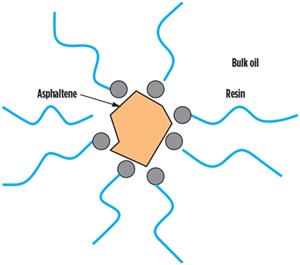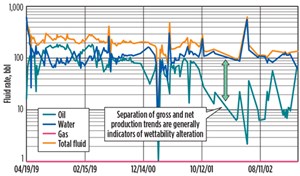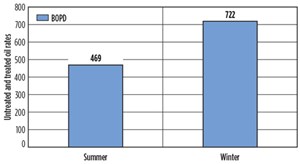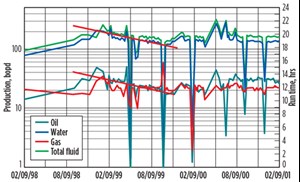Decline curve analysis identifies enhancement treatments for heavy oil reservoirs
Extracting low gravity, heavy oil can induce reservoir damage and negatively impact productivity. A lack of understanding of damage-triggering mechanisms can lead to the misapplication of conventional or unconventional treatments. This can cause further formation damage and result in premature abandonment, leaving recoverable hydrocarbons in the ground.
To mitigate these risks, and select suitable mature assets for stimulation, operators can use decline curves to detect unnatural changes in production trends, which often can be correlated back to surface interventions. Purvis provided a summary of decline curve analysis in terms of graphical presentation and rate/time guidelines.1
To select the best candidate wells, a five-year analysis is recommended. Beyond that, it becomes difficult to filter out noise. Although a longer look back can uncover evidence where damage might be removed, for optimal candidate selection, the shorter time span has proven more beneficial.
UNDER-PERFORMING WELLS
Often, a first reaction to low performance is to acidize the well to stimulate production. While most engineers are comfortable with the concept, this action is not always the best choice. Field experience evaluating production profiles and well histories of underperforming and damaged wells has defined profile patterns that are consistent with different types of formation damage.2
While the techniques of production profile analysis don’t always properly ascertain damage type, the majority of wells identified using this technique do respond to chemical treatments based on the assessment.
The technique relies on detailed profile evaluation, and a thorough review of the subject well’s history, in addition to adjacent producers. The in-depth study yields clues into the types of problems being experienced in the field. The different types of damage profiles observed in heavy oil environments are discussed below.
PRODUCTION PROFILES
Production profiles evaluated in semi-log coordinates have, historically, been used for decline curve analysis. The analysis clearly defines production trends that deviate from normal decline trends and provides points of reference for changes associated with surface events. Production rates plotted on Cartesian coordinates do not provide the level of definition that semi-log coordinates do, and are not as instructive. We recommend three-cycle semi-log coordinates, as they provide the definition necessary to identify specific trends. The critical production rate data plotted are oil, water and natural gas.
Heavy oil reservoirs produce low-gravity crude with high asphaltene content, which gives the liquid a dark, rich color. Unlike paraffins, asphaltenes are not part of the oil, but exist in a colloidal dispersion. The colloid is stabilized by an outer ring of lighter molecular weight resins that stabilizes the asphaltene micelle and keeps it dispersed in the oil, Fig. 1. Any action that destabilizes the asphaltene micelle will cause asphaltenes to flocculate and precipitate out of solution.3,4 When organic deposition occurs in the reservoir, a change in relative permeability is often observed, due to the oil-wetting effect of organic material.
The most common damage mechanism in heavy oil reservoirs is often triggered by steam used to extract the crude. Steam contributes to damaged wells in several ways, and the extreme temperatures are one of the most common damage-triggering mechanisms. Asphaltenes start to decompose at temperatures greater than 300°C, due to the flashing off of lighter, molecular-weight maltenes that help stabilize the asphaltene micelle. Regardless of whether a well is a steam-flooded producer, or a cyclic steam well, the produced fluids will experience temperatures high enough to destabilize the asphaltene micelle and cause asphaltenes to agglomerate.
Since asphaltenes are polar in nature, they will attach to negatively charged reservoir surfaces and establish nucleation sites for further deposition. These deposits, which can become several angstroms thick, can alter the relative permeability to oil (kro) in the critical matrix of the well zero to 24 in. into the reservoir. Since all fluid produced from a well must flow through the critical matrix, a well whose kro has been negatively impacted, will have an improved relative permeability to water (krw), and thus result in higher water production and diminished permeability to oil.5
This change in kro will display a unique signature on a semi-log production plot that manifests itself as a net production trend, diverging away from the gross production trend, Fig. 2. Decline curve analysis is performed on steady gradual decline trends, and this example clearly shows a rapid change in the production rate, therefore signaling that a recent event is most likely responsible for this change in wettability profile and not caused by natural decline. Since the water cut is generally 95% or greater in most heavy oil producing wells, the gross or water trend is not impacted as severely as is the net trend, Fig. 2.
A well experiencing this type of production profile is a prime candidate for a multifunctional treatment program featuring a solvent, surfactant and dispersant package. The combination is required to remove the damaging material, and return the reservoir surface to a water-wet condition, such that kro will be improved.
Treatments using xylene, hot water, acid, and low surface tension fluids, such as diesel and kerosene, are ineffective, as these fluids are not multifunctional and have a finite solvent, heat transfer, or dissolution properties. They can’t solvate, disperse and repair the formation face.
The other damage mechanism common in heavy oil environments is emulsion damage that occurs when high energy is introduced into an environment where two immiscible fluids are readily available in the presence of a stabilizing agent. Such is the case of a producing well that is treated periodically with 5,000 to 10,000 bbl of steam, to warm up the near-wellbore or to connect to a steam flood. Injecting 50%- to 70%-quality steam can introduce a high level of energy into a producing well, which can emulsify reservoir fluids. The emulsion becomes stable when formation fines, sand/silt accumulate at the interface of the emulsion droplets, which make it difficult for water droplets to coalesce, giving the emulsion long lived stability, even at elevated temperatures.
Emulsions also can be created by surface interventions, such as pump changes, tubing wash-backs, jet washes, cup washes, and the introduction of quench or kill fluids. These are all common practices in heavy oil reservoirs. A review of the well history will often associate the observed change in production with a surface event. Since most oilfield emulsions are water internal/oil external, the open flow paths between emulsion droplets are oil-wet surfaces, which produce that same change in relative permeability profile as organic deposition, only the onset is acute and results in a step-change in production.6
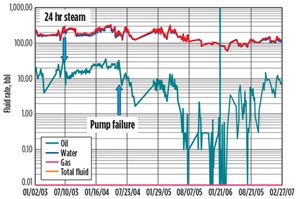
Figure 3 demonstrates emulsion damage and acute change in kro associated with a surface intervention, including a cyclic steam application and a pump change-out. The step-rate change in production after the cyclic steam application could be a function of organic precipitation, as discussed in the earlier example, or it could simply be an emulsion issue. The second step-rate change observed during the pump failure is more likely due to an in-situ emulsion created with the quench or kill fluids. Note again that water production is not impacted as dramatically as net production. Only in the most severe of emulsions will both net and gross production be impacted. In this case, emulsion droplets are so small (high emulsion quality) that they bridge across the pore throat openings, effectively preventing the flow of any fluids.7
Both problems can be remediated effectively by batch treatments of multifunctional solvents, surfactants and water-wetting agents. However, operational experience in heavy oil reservoirs indicates that while a straight demulsifier would likely be effective in resolving the emulsion created during the pump change, a more robust treatment response would be delivered by combining a demulsifier with the multifunctional product. Better responses have been observed when using both solvent/surfactant blends in a situation where an emulsion problem is suspected, indicating that prior damage may be being resolved beyond the acute event that triggered the most recent drop in production.2
CONVENTIONAL APPROACH
The conventional approach to enhance production on a under-achieving well is to acidize the reservoir. In a few rare occasions, an acid treatment might reinitiate production, but not because the solution dissolved damage, but rather because of the sheer volume of fluid typically used in a typical treatment.
When wells are acidized, most operators subscribe to the philosophy that more is better and, as such, acid treatments often consist of several thousand gallons of fluid. Because precipitated asphaltenes and emulsions are amorphous, the volume of fluid pumped during an acid treatment is sufficient to move the damage away from the near-wellbore and temporarily open flow paths to the pumping equipment. Operators often will experience a significant increase in gross production, but little-to-no improvement in net production, as acid does not solubilize organic material, and the additive packages in acid systems aren’t usually robust enough to improve the water-wetting properties of the reservoir rock.
Another reason for a lack of response is that acid systems can destabilize the asphaltene micelle, causing asphaltenes to precipitate out of solution, exacerbating the problem. If a well does respond to an acid treatment, it is often by accident, and has more to do with the solvent and surfactant packages in the pre-flush, not because of the acid system, itself.
Hot water stimulus. Other treatment techniques attempted on heavy oil under-producing wells are hot water dumps down the annulus or tubing. These types of treatments appear to help stimulate production and are popular with operators, because they are relatively low-cost, however; while some wells do seem to respond to the hot water dumps, they do so not because of the heat imparted onto the reservoir fluids, but because once again, amorphous precipitated organics or emulsion damage are displaced away from the critical matrix of the wells. This action opens up flow paths into the wellbore. An increase in gross production is generally observed, but only until the damage migrates back to the near-wellbore, which can happen in days. Hot water will not resolve an emulsion or solubilize organic damage, nor improve kro after the reservoir reaches a certain temperature.5
Aromatic solvents. A third method popular with heavy oil operators is the use of aromatic and sometimes aliphatic solvents to attempt to stimulate production. While it is true that organic material such as asphaltenes and paraffin are soluble in aromatic solvents; straight aromatic solvents do not have dispersant, demulsification, or surfactant properties and cannot truly repair an oil-wet reservoir surface or effectively resolve an emulsion. Aliphatic solvents, such as diesel and kerosene, have been used in heavy oil reservoirs to attempt to clean up organic deposits and lower fluid viscosity. Using this low-cost method to solubilize heavy organics and reduce viscosity sounds good, but low surface tension fluids can actually strip away lighter molecular weight resins that stabilize the asphaltene micelle in heavy crude, and cause additional organic precipitation.8
Lifting issues. Another heavy oil challenge is pumping cold, viscous crude to the surface without a steam drive or cyclic steam support. Wells in this category experience sticking, flumping, floating rods, blown stuffing boxes, and high flowline pressures. These wells generally can be produced during the summer, when ambient surface temperatures are high enough to heat flowlines and reduce oil viscosity and friction pressure issues. However, even during warm months, the downhole temperatures may not be sufficient to reduce viscosity, and the associated issues caused by cold fluids. Some operators may resort to adding a diluent, but as discussed above, this strategy may cause more problems than it solves. A preferred alternative is to inject an emulsifier to purposely create an oil-in-water emulsion.3
Because the viscosity of water is much lower than oil, the reverse emulsion creates an effect, as if the well is pumping only water. This reduces the effects of viscous fluid, in addition to friction downhole and in the flowline. It also eliminates fluid pound and floating. By continuously applying the reverse emulsifier, wells that could not be produced in winter are now able to efficiently pump year-round. The treatment has increased production 250 bopd during the winter, compared to summer months when no treatment was in place, Fig. 4.
Calcium carbonate deposits. Another difficulty experienced by heavy oil operators is when CaCO3 scale precipitates out of solution, due to an oversaturation of minerals in the produced fluid. This is a challenging situation, as the likelihood of CaCO3 scale escalates as temperature rises. Similar to the other problematic case examples listed above, these scale-encrusted wells also have a signature curve profile. Wells affected by scale precipitation often present a synchronous decline of both water and net production trends. As scale precipitates and starts plugging perforations or liner slots, it impacts production uniformly, and a large percentage of wells damaged by scale present a similar production profile, Fig. 5. In this scale profile, a best-fit line drawn through the water and oil trends, parallel to each other, gives the scaling well its own unique signature.
Addressing scaling in hot, heavy oil wells presents several unique challenges. The presence of precipitated organics and emulsion damage is an issue, but now the challenge becomes how to remove scale in a hot environment without mechanically damaging tubulars and precipitating additional damage. Given these difficulties, the best course of action is to remove the existing mineral damage and then prevent it from occurring again through preventative measures, such as scale inhibition treatments. This course of action is effective in high-temperature environments, provided they are properly designed and placed.
TREATMENT PROGRAMS
Identifying candidate wells and the suspected damage mechanism is the first step in identifying a solution. Because it is rare when just one damage mechanism negatively impacts well performance, reviews of the well history often can provide insight into treatment strategies. Using this analysis helps the operator to identify the proper stimulation program, to return the well to its optimal production rate. In most cases, the use of multi-functional treatment products is critical to achieving success.
Another key factor in optimizing a treatment regime is performing a wet analysis on samples gathered from the damaged wells during recent workover events. The newer the sample, the better data that it will provide, as aged samples will oxidize and change over time, and may become resistant to a treatment program. The wet analysis in the laboratory provides the engineer an opportunity to screen different products, and to optimize chemical concentrations to remediate the problem.
Most chemical applications on underperforming wells can be applied in batch treatments down the annulus, because the placement technique is not critical. The primary objective is to maximize the time that the chemicals are in contact with the offending deposits. As the deposits did not occur instantaneously, the issue will not be resolved instantaneously, either. Operational experience has proven that a 24-hr soak time for a non-acid application is adequate to clean up most of the discussed damage mechanisms.
CONCLUSION
Maintaining optimal rates from heavy oil reservoirs presents several unique challenges. In many cases, an in-depth study or laboratory analysis is not economically feasible. Years of field experience evaluating under-performing wells has yielded several unique production trends associated with different types of damage. It is important to recognize and fully understand these damage mechanisms, to ensure that engineering personnel have the necessary tools to select the proper treatment for a specific application. Using these distinctive signatures will minimize risk and help engineers identify the most appropriate treatment program.
Caveat. These examples provide general guidelines, but there will be exceptions. Carboxylic acids are not common in the U.S., but they have been identified in heavy oil fields in California and will be the subject of future publications. ![]()
REFERENCES
- Purvis, D.C., “The practice of decline curve analysis,” SPE paper 179979, presented at the SPE/IAEE Hydrocarbon Economics and Evaluation Symposium, Houston, Texas, May 17–18, 2016.
- Castro, L.U., “Demulsification treatment and removal of in-situ emulsion in heavy oil reservoirs,” SPE paper 68852 presented at the SPE Western Regional Meeting, Bakersfield, Calif.
March 26–30, 2001. - Newberry, M.E., “Chemical effects on crude oil pipeline pressure problems,” JPT,
pp. 779–786, 1984. - Lichaa, P.M. and L. Herrera, “Electrical and other effects related to the formation and prevention of asphaltene deposition problems in Venezuela crudes,” presented at the International Symposium on Oilfield Chemistry, Dallas, Texas, Jan. 16–17, 1975.
- Bennion, D.B., F.B. Thomas, and D.A. Sheppard, “Formation damage due to mineral alteration and wettability changes during hot water and steam injection in clay-bearing sandstone reservoirs,” SPE paper presented at SPE International Symposium on Formation Damage Control, Lafayette, Louisiana, Feb. 26–27, 1992.
- Bennion, D.B., M.Y. Chan, and G. Sarioglu, “The in-situ formation of bitumen-water-stable emulsions in porous media during thermal stimulation,” SPE paper 25802, presented at International Thermal Operations Symposium, Bakersfield, Calif., Feb. 9–10, 1993.
- Cuthiell, D., K. Green, and R. Chow, “The in-situ formation of heavy oil emulsions,” SPE paper presented at the International Heavy Oil Symposium, Calgary, Alberta, Canada, June 19–21, 1995.
- Newberry, M.E., “Crude oil production and flowline pressure problems,” Production Operation Symposium, Oklahoma City, Oklahoma, Feb. 27–March 1, 1983.
ACKNOWLEDGEMENT
This article was adapted from SPE paper 185742-MS, which was presented at the Western Regional Meeting held in Bakersfield, Calif., April 23–27, 2017.

